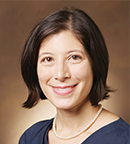Consider a patient who is referred for neoadjuvant therapy for stage IIIA, HER2-positive breast cancer. She is otherwise healthy, with no significant medical history, an Eastern Cooperative Oncology Group performance status of 0, unremarkable baseline labs, and a left-ventricular ejection fraction of 60%. Now, add one more number to her chart review: She is 80 years old. How should you think about her treatment plan, and what evidence sources should you rely upon in making your recommendations?

Emily Castellanos, MD, MPH

Neal J. Meropol, MD
Over a decade ago, a series of studies raised concerns about the generalizability of clinical trials to older patients with cancer, due to the discordance between the age of trial participants and the general cancer population.1,2 Since then, we have witnessed a golden era of oncology research, with a multitude of new therapies and a deeper understanding of cancer biology. However, when it comes to participants in clinical trials, the age gap persists.
A recent review of more than 300 clinical trials found that participants are, on average, more than 6 years younger than the general population.3 For phase III trials of targeted therapies, differences are even wider—nearly 10 years.3 Oncology has seen great progress, but the skewed age distribution of patients who participate in clinical trials raises the question: Are these studies applicable to the older patients we see in the “real world”?
Although older adults remain sparsely represented in clinical trials, they are now the fastest-growing segment of patients with cancer in the United States. It is expected that the proportion of patients with cancer older than age 65 will double in the next 10 to 20 years, and by 2030, more than 70% of new cancer diagnoses will occur in this age group.4 The population of the “oldest old,” commonly defined as adults 85 years of age or older, comprises 2% of the U.S. population,5 but it is projected to account for 9% of new cancer diagnoses by 2030.6
Guest Editor

Stuart M. Lichtman, MD, FASCO
Understanding potential age-related differences in the pharmacologic properties, toxicities, and efficacy of novel treatments is more critical than ever; however, we can’t draw conclusions from clinical trials if elderly patients are not included. Moreover, the older patient population is far from monolithic; a healthy 80-year-old may have a life expectancy comparable to a 65-year-old with activity-limiting comorbidities. Inclusion of geriatric assessment in clinical trials has been recommended to better understand the functional status, comorbidities, and cognitive function of older trial patients7; however, few studies have done so, and such evaluations are not commonly conducted in routine care. Applying the outcomes of a trial population to an actual elderly patient may thus require some “hand-waving” to see how the study fits, and this lack of evidence may result in heterogeneity of practice and potential undertreatment of older adults. One study of survival disparities in the United States found advances in oncology have disproportionately benefited younger patients, thought to be due in part to differences in care for older adults.8
Building an Evidence Base for Older Patients
How can we build the evidence base for older patients with cancer? One obvious solution would be to include more older patients in clinical trials, thus making studies more representative. Clinical trials, however, are not the only potential source of evidence; observational data can also provide valuable insights into the clinical outcomes of older adults.
Observational data are collected outside of an experimental intervention and may be collected with or without a research purpose. In oncology, the Surveillance, Epidemiology, and End Results (SEER) program or state-sponsored cancer registries are prime examples of prospectively collected, observational data; they have long been used to identify population trends or disparities in care. However, data do not have to be captured for research purposes to be useful. Real-world data, defined as data generated during the process of routine care, may be collected throughout the health-care system, including medical claims and billing data, product or disease registries, patient-generated data from in-home or clinic settings, or data properly derived from the electronic health record itself.
De-identified real-world data may be leveraged for studies of clinical effectiveness, as a complement or surrogate for efficacy as assessed in clinical trials. Efficacy measures the impact of an intervention under controlled circumstances. In contrast, effectiveness is the measure of an intervention’s performance under “real-world” conditions and may be impacted by factors such as treatment availability, acceptance, and adherence.
Assessing Treatment Utility in Older Patients
Effectiveness research in older patients requires special considerations in the design and interpretation of studies, including differences between chronologic and physiologic age, life expectancy, or other competing risks such as medical comorbidities or polypharmacy. For older patients, a well-designed clinical effectiveness study may provide a practical assessment of a treatment’s utility. Such studies may raise alarm bells if a lack of benefit or undue toxicity is seen, but they also may provide reassuring evidence that using a given agent in an older patient population is safe and beneficial. For instance, de-identified real-world data from electronic health records have demonstrated not only that treatment of elderly patients with programmed cell death ligand 1 therapy is common,9 but that such patients have similar overall survival outcomes compared with their younger counterparts.10
“De-identified real-world data may be leveraged for studies of clinical effectiveness, as a complement or surrogate for efficacy as assessed in clinical trials.”— Emily Castellanos, MD, MPH, and Neal J. Meropol, MD
Tweet this quote
If therapies are not as effective in routine practice as trial results suggest, then real-world data can also be used to help us understand why. Older adults may have differing physiology or other comorbidities that would have led to their exclusion from a clinical trial but that also may reduce the effectiveness of a given therapy.11 Treatment effectiveness may also be impacted by practical considerations, which may not be as visible in the controlled circumstances of a clinical trial.
Practical Considerations in Treatment Effectiveness
Insurance claims data, for example, allow quantification of the cost of care. Linking such sources with clinical data can illuminate how financial burden may affect clinical outcomes, including treatment adherence.12 Data from electronic health records or claims may be used to understand acute health-care resource utilization, such as emergency room visits or hospitalizations, which have implications for costs, quality of life, and functional independence for older patients.
Creative integration of claims data with geographic software, such as Google Maps, has demonstrated the impact of travel time on patient costs and receipt of care.13 As technology evolves, real-time data on daily activity, captured through electronic wearables, may provide other opportunities to understand a patient’s fitness. In such ways, real-world data can provide a window into the complex ecosystem in which a patient’s treatment occurs.
As the population ages, narrowing the gap between clinical trials and the real world has never been more critical. At the same time, the growing breadth and quality of real-world data have never been richer, providing opportunities to contextualize the results of clinical trials and also to inform clinical trial design itself, by ensuring that inclusion and exclusion criteria result in a study population that is reflective of patients we see every day. In real-life practice, older patients are more than a small subgroup analysis—they are the face of the overall population. We should be able to learn from our collective experience.
Dr. Castellanos is Associate Medical Director of Research Oncology and Dr. Meropol is Vice President of Research Oncology, Flatiron Health Inc., New York.
DISCLOSURE: Dr. Castellanos and Dr. Meropol are employed by Flatiron Health, an independent subsidiary of the Roche Group, and own stock or have other ownership interests in Flatiron Health and Roche. Dr Meropol holds a patent for “methods of therapy for cancers characterized by overexpression of the HER2-receptor protein.”
REFERENCES
1. Hutchins LF, Unger JM, Crowley JJ, et al: Underrepresentation of patients 65 years of age or older in cancer-treatment trials. N Engl J Med 341:2061-2067, 1999.
2. Talarico L, Chen G, Pazdur R: Enrollment of elderly patients in clinical trials for cancer drug registration: A 7-year experience by the U.S. Food and Drug Administration. J Clin Oncol 22:4626-4631, 2004.
3. Ludmir EB, Mainwaring W, Lin TA, et al: Factors associated with age disparities among cancer clinical trial participants. JAMA Oncol. June 3, 2019 (early release online).
4. Smith BD, Smith GL, Hurria A, et al: Future of cancer incidence in the United States: Burdens upon an aging, changing nation. J Clin Oncol 27:2758-2765, 2009.
5. DeSantis CE, Miller KD, Dale W, et al: Cancer statistics for adults aged 85 years and older. CA Cancer J Clin 69:452-467, 2019.
6. Gundrum JD, Go RS: Cancer in the oldest old in the United States: Current statistics and projections. J Geriatr Oncol 3:299-306, 2012.
7. Hurria A, Levit LA, Dale W, et al: Improving the evidence base for treating older adults with cancer: American Society of Clinical Oncology statement. J Clin Oncol 33:3826-3833, 2015.
8. Zeng C, Wen W, Morgans AK, et al: Disparities by race, age, and sex in the improvement of survival for major cancers: Results from the National Cancer Institute Surveillance, Epidemiology, and End Results (SEER) program in the United States, 1990 to 2010. JAMA Oncol 1:88-96, 2015.
9. Khozin S, Abernethy AP, Nussbaum NC, et al: Characteristics of real-world metastatic non-small cell lung cancer patients treated with nivolumab and pembrolizumab during the year following approval. Oncologist 23:328-336, 2018.
10. Khozin S, Carson KR, Zhi J, et al: Real-world outcomes of patients with metastatic non-small cell lung cancer treated with programmed cell death protein 1 inhibitors in the year following U.S. regulatory approval. Oncologist 24:648-656, 2019.
11. Lu-Yao G, Nikita N, Keith SW, et al: Mortality and hospitalization risk following oral androgen signaling inhibitors among men with advanced prostate cancer by pre-existing cardiovascular comorbidities. Eur Urol 77:158-166, 2020.
12. Dusetzina SB, Winn AN, Abel GA, et al: Cost sharing and adherence to tyrosine kinase inhibitors for patients with chronic myeloid leukemia. J Clin Oncol 32:306-311, 2014.
13. Lin CC, Bruinooge SS, Kirkwood MK, et al: Association between geographic access to cancer care, insurance, and receipt of chemotherapy: Geographic distribution of oncologists and travel distance. J Clin Oncol 33:3177-3185, 2015.

